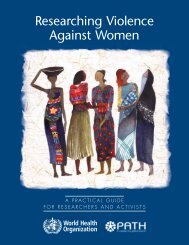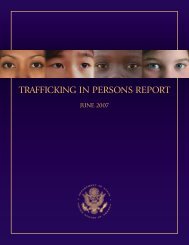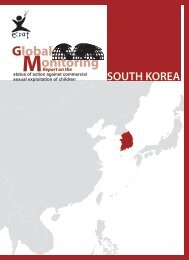Download PDF - Violence Against Children - East Asia and the ...
Download PDF - Violence Against Children - East Asia and the ...
Download PDF - Violence Against Children - East Asia and the ...
You also want an ePaper? Increase the reach of your titles
YUMPU automatically turns print PDFs into web optimized ePapers that Google loves.
Vietnam<br />
7. The project has used <strong>the</strong> World Health<br />
university <strong>and</strong> its graduates will still be<br />
Organization CBR training manual, <strong>the</strong><br />
<strong>the</strong>re engaging with <strong>the</strong> local community.<br />
h<strong>and</strong>book Disabled Village <strong>Children</strong> (David In short, NGOs “need to partner more<br />
Werner, 1988), Training in <strong>the</strong> Community with universities, making <strong>the</strong>m part of our<br />
for People with Disabilities (WHO, 1989) project design... <strong>the</strong>y are a wonderful<br />
<strong>and</strong> Nothing About Us Without Us (David resource”. 10<br />
Werner, 1998). The project has also<br />
The practices described in <strong>the</strong> CBR project<br />
created many new activities of its own<br />
are in keeping with key recommendations of<br />
making, as events warranted.<br />
<strong>the</strong> CAN study: 11<br />
8. Integration is a primary aim. According to<br />
• Families are supported in practical ways.<br />
World Vision Vietnam CEDC specialist Dr<br />
Michael Hegenauer, who helped establish<br />
• <strong>Children</strong> with disabilities are increasingly<br />
this project,<br />
included in <strong>the</strong> concept of community. The<br />
community becomes richer as it involves its<br />
“It is not developing ‘special services’; it is<br />
disabled children. Attitudes <strong>and</strong> practices<br />
simply having <strong>the</strong> community <strong>and</strong> our<br />
that are harmful to its most vulnerable<br />
development programs include children with<br />
members can be challenged <strong>and</strong> changed<br />
disabilities in <strong>the</strong> activities that are already<br />
with tangible results.<br />
being delivered (health care, education,<br />
culture/leisure/play, child participation, etc.).<br />
• The participation of disabled children is<br />
Part of key learning here is that it's not that<br />
encouraged, has an avenue <strong>and</strong> <strong>the</strong>ir views<br />
children with disabilities can't participate – it's<br />
are heard as issues affecting <strong>the</strong>m become<br />
that we don't let <strong>the</strong>m participate... we don't<br />
recognised. Communities, local government<br />
even think about letting <strong>the</strong>m participate.”<br />
<strong>and</strong> volunteer CBR workers toge<strong>the</strong>r have<br />
started to organise social occasions (with<br />
Development agencies need to<br />
project funds), such as a Têt (lunar new year)<br />
intentionally develop project designs,<br />
party <strong>and</strong> a Christmas party, to which all<br />
objectives, activities, indicators <strong>and</strong><br />
children are welcome – whereas before<br />
benchmarks that engage this target group.<br />
<strong>the</strong>re were none for children who did not go<br />
Many project designs appear very weak in<br />
to school (not only children with disabilities,<br />
this area <strong>and</strong> in <strong>the</strong> Vietnamese context it<br />
but street children, <strong>and</strong> children without<br />
has been critical to address this.<br />
residence registration or a birth certificate).<br />
9. Sustainable impact is greatly enhanced<br />
• Links with <strong>the</strong> University have assisted with<br />
when <strong>the</strong> project has <strong>the</strong> support of<br />
outcome-focused research.<br />
active partners. University involvement<br />
has been especially important: partnering<br />
• Changes in attitude <strong>and</strong> action have<br />
with <strong>the</strong> University of Ho Chi Minh’s<br />
followed planned awareness-raising efforts<br />
Departments of Social Work <strong>and</strong> Women’s<br />
where both <strong>the</strong> problem <strong>and</strong> <strong>the</strong> potential<br />
Studies, for example, has led to exchanges<br />
have been presented. This is important, as<br />
on medical <strong>and</strong> psycho-social rehabilitation/<br />
awareness-raising does not always move<br />
CBR, <strong>and</strong> cultural aspects of disabilities.<br />
beyond <strong>the</strong> problem. If <strong>the</strong> potential for<br />
Exposure assists with training of students;<br />
change is not presented when <strong>the</strong> attention<br />
it is here that <strong>the</strong> bright young people of a<br />
of families or <strong>the</strong> broader community has<br />
country can learn <strong>and</strong> get involved. It is<br />
been brought to an issue of social<br />
here that research can be delivered <strong>and</strong><br />
importance, <strong>the</strong>re is a risk of apathy.<br />
it’s here that national policies can be • Working with people in positions of power<br />
developed or challenged. Agencies can helps to gain support on child protection<br />
influence, but when that NGO packs up from local authorities. Projects need to<br />
<strong>and</strong> leaves or that donor stops giving, <strong>the</strong> actively inform <strong>and</strong> involve key figures in<br />
10 Dr Michael Hegenauer, World Vision Vietnam<br />
11 Dorning, K, Crying Out, World Vision International, 2002<br />
81

















